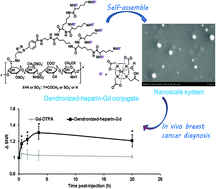A dendronized heparin–gadolinium polymer self-assembled into a nanoscale system as a potential magnetic resonance imaging contrast agent
Abstract
We reported the preparation and characterization of a dendronized heparin–gadolinium polymer (Dendronized-heparin–Gd) based nanoscale system as a potential MRI contrast agent, which combined the advantages of heparin and the peptide dendron. The dendronized polymer self-assembled into a compact nanoscale system, which was confirmed by dynamic light scattering (DLS) and scanning electron microscopy (SEM) results, and a negative charge was observed. The content of gadolinium (Gd(III)) was 6% as a weight percentage, determined by inductively coupled plasma mass spectrometry (ICP-MS) analysis. The in vitro and in vivo toxicity studies demonstrated that the Dendronized-heparin–Gd polymeric nanoscale system exhibited good biocompatibility – no obvious side effects to normal cells and organs of healthy mice were observed by a cytotoxicity assay, body weight shift and histological analysis. The polymeric nanoscale system showed a 7-fold increase in the T1 relaxivity compared to the clinical agent Magnevist (Gd-DTPA). In vivo MR imaging studies on the mice bearing 4T1 breast tumors showed that the nanoscale system had a much higher contrast enhancement in the tumor than Gd-DTPA. The distribution of Gd(III) in the tissues at different times after administration indicated a higher Gd(III) accumulation in the tumor for the nanoscale system compared to Gd-DTPA. Overall, the dendronized heparin polymer based nanoscale system with a high contrast enhancement in tumors and low side effects may be used as a MRI contrast agent for disease diagnosis.


 Please wait while we load your content...
Please wait while we load your content...